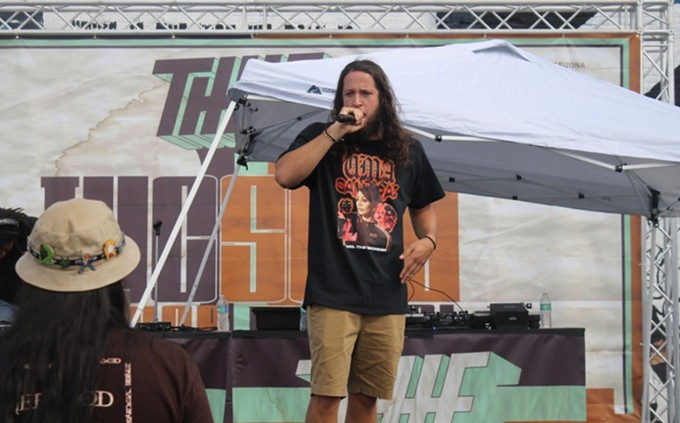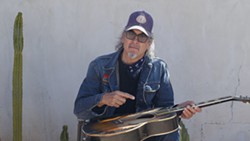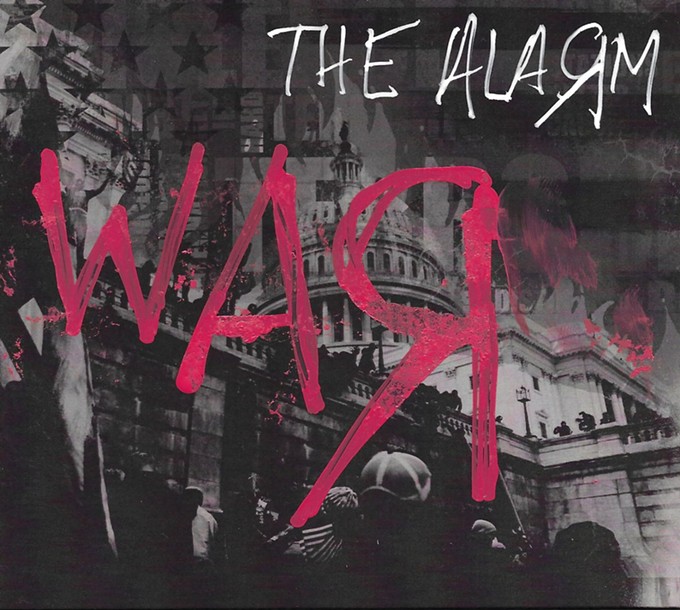Thursday, May 5, 2022
Lila Downs took to the stage like a chiltepin—a wild chili pepper known for producing intense heat despite its diminutive size—at Centennial Hall (Thursday, April 28) kicking off the annual Agave Heritage Festival.
Early in the set, horn section ablaze, Downs tore into “Son del Chile Frito”—a track imbued with fiery cumbia rhythms from Al Chile (2019), her latest release—setting the tone for evening.
A gifted dancer, her body undulated across the stage.
Tags: Lila Downs , Centennial Hall , Xavier Omar Otero , Live Music Review , Image
Thursday, March 24, 2022
The Tucson Hip Hop Festival returned after a two-year hiatus on March 19 and 20. The two-day event began with a celebration of talent in a block party at 191 Toole, and the second day held educational seminars at the University of Arizona Poetry Center.
“I heard the event was coming back after COVID-19 and I just wanted to come here with the whole community and just have a good time,” local breakdancer Vortex said.
The four elements of hip-hop were showcased and discussed throughout the weekend: break dancing, deejaying, rapping, and graffiti. Artists at the festival were encouraged to push themselves to their limits, with various contests and battles.
“[Graffiti is] the only form of art where the artist never has to touch the surface,” local graffiti artist Yeroh said. “You can be as creative as you want and there’s no limitation for what you can do except for creativity.”
The elements share a common theme of accessibility and freedom, as they stem from hip-hop’s roots in the urban parts of the East Coast, with art being cultivated from whatever resources were available to the creators.
“Hip-hop is both music and culture seated in Black folks’ history and ways of moving through the world presently,” said UA Africana Studies professor Erika Gault. “The more that we understand [hip-hop] and its present concerns then the more we can understand it historically too.”
Gault was among the panelists who spoke during the second day of the event. Discussions included a chronicle of religion, cultural diversity and justice in hip-hop, a conversation on how to cross the urban world as a graffiti artist, a Q&A session with successful music industry figures on what it takes to make it and much more.
“Anybody that I know that is successful, the number one story that they all talk about is just not giving up,” said Juan Fleischer, Nogales native and producer and music engineer for Atlantic Records and Artist Partner Group. “There’s just a lot of stories of the struggle, and the cards can totally be against you, but successful music people turn those cards to make it positive for them.”
Despite much of the community rejoicing at the festival’s return, some attendees also pointed out that there could be room for improvement.
“I think it was fun but it definitely needed more people, more vendors and better space,” attendee Myana Hibbert said. “But this is the first year after [COVID-19] and being closed down so I’ll give them a break.”
But attendees, artists, and panelists alike hope that this is only the beginning for the festival’s return, one they feel Tucson needs.
“A lot of ways when we think about hip-hop we think more about the East Coast, and more recently the West Coast, but never the Southwest,” Gault said. “So the kind of connections and communities that are right here in Tucson and the surrounding areas is really important to showcase.”
For more information, visit tucsonhiphopfestival.com
Monday, October 18, 2021
Four years ago, Liverpool, England, the city that begat the Beatles, commissioned renowned choreographer Mark Morris to create a dance that would honor the 50th anniversary of Sgt. Pepper’s Lonely Hearts Club Band, one of the Beatles' most influential albums.
Two years ago, the Mark Morris Dance Group was touring the U.S. with the piece, dubbed Pepperland.
A tribute to the Beatles, the 70-minute dance was a jazzy explosion of color, with innovative modern dance moves and plenty of music, including six Beatles songs. The Washington Post found the dance ravishing.
“Pepperland is an ecstatic and provocative Beatles tribute,’’ dance writer Sarah L. Kaufman declared, “and like no land you’ve been to before.”
Regrettably, that dancing Beatle land did not come to Tucson that year. Because in the midst of all the praise, Pepperland went dark. COVID had descended and the tour shut down. Tucson would have to wait.
Like every other choreographer, Morris spent much of the past year and a half stuck in the studio, but he used the time to experiment with new ways to dance.
Instead of leading some of the nation’s best modern dancers across America’s stages, he put them in dance videos, filmed in lonely New York apartments, with the performers dancing solo. The online videos were a hit, and bit by bit, the troupe ventured carefully back into the world. During the past month, the ever-innovative Morris debuted new works created during the pandemic time. The dancers performed them outdoors in different parts of the Big Apple.
Friday, October 1, 2021
The Whole Enchilada Trailer from R&R Press on Vimeo.
This weekend's Tucson Film & Music Festival will include the premiere of The Whole Enchilada, a documentary that explores Tucson’s music scene from the late 1970s through the mid-’90s.
Local filmmaker Maggie Smith captures the origins of desert rock through the words and sometimes fuzzy recollections of those who survived. The fertile scene arose from cross pollination between country, rock and punk, with the growth “largely fueled by the drug trade,” recalls George Hawke (The Dusty Chaps, Los Lasers).
The story unfolds in a series of exclusive interviews and never-before-seen footage with local luminaries: Country rockers Bob Meighan, Ned Sutton (The Rabbits), and George Hawke, alt-rock legends Dan Stuart (Green on Red), Howe Gelb (Giant Sand), Bill Sedlmayr (The Pedestrians, Giant Sandworms), Robin Johnson (The Pills, Gentlemen Afterdark), David Slutes (Sidewinders, Sand Rubies), Van Christian (Naked Prey), “wild child” Suzie Caruze and others.
Maggie Smith became involved in the project about a year ago when her husband (and Tucson Weekly columnist) Brian Smith met with executive producer of The Whole Enchilada Rich Hopkins.
“Brian is the editor of the liner notes/book of essays that accompanies the [companion] 3 LP set Whole Enchilada and I pitched the idea to Rich of directing an accompanying film,” Maggie Smith said.
Maggie Smith said she was already planning screenings at this weekend's premiere.
“We are planning to submit to other festivals, and to screen the film in Phoenix and again in Tucson at Hotel Congress to coincide with the box set release in March 2022," Maggie Smith said. "All people who purchase the box set will receive a code to watch the documentary via streaming."
Tags: Maggie Smith , The Whole Enchilada , Bob Meighan , George Hawke , Ned Sutton , Dan Stuart , Howe Gelb , Robin Johnson , David Slutes , Rich Hopkins , Van Christian , Suzie Caruze , Jim Brady , Xavier Omar Otero , Image
Friday, September 10, 2021
Join Arizona Public Media and the Pima County Public Library in celebration of the rich Mexican-American and Latinx cultural heritage of Southern Arizona during Mes de la Cultura! Enjoy a virtual celebration of Mexican-American and LatinX art, music, and dance with performances by Mariachi Estrellas de Tucson, Mariachi Los Changuitos Feos, and Ballet Folklórico Tapatío.
You’ll get a first look at Arizona Illustrated’s story about Carlos Valenzuela, a Chicano tile artist, and his work across Tucson’s south side. Plus, you’ll get an inside view of the Pima County Public Library’s Frank De La Cruz Borderlands collection!
After the show, performers will be sharing more about the rich cultural history of these art, music and dance forms, share some of their own experiences performing, and answering YOUR questions during a live Q&A. We hope you’ll join the conversation!
This event is sponsored by Arizona Public Media, and the Library's Welcome to America and Nuestras Raíces teams.
About the Performers
Mariachi Estrellas de Tucson is a youth mariachi group from Tucson. With performers ranging in age from 10 to 17 years old, the group has participated in the Tucson International Mariachi Conference in Tucson, Arizona, and the Rosarito International Mariachi Conference in Rosarito, Baja California, México.
Mariachi Los Changuitos Feos (LCF) is widely regarded as the first youth mariachi group and the first seed of the growing youth mariachi movement in the United States. The group includes twelve high-school aged musicians under the direction of Salvador Gallegos. Founded in 1964, LCF now carries a five-decade legacy of musicianship and dedication.
Ballet Folklórico Tapatío (BFT) is a non-profit folkloric dance group established in 1997 under the direction of Jose Luis Baca and Marissa Gallegos. This group is based in South Tucson, and has over 150 members. They have performed throughout the United States, Mexico and Colombia, and are recognized as one of the finest folkloric programs in the nation.
Friday, June 18, 2021
On June 19, 1865, Union soldiers marched into Galveston, Texas, and announced the end of the Civil War, two years after President Abraham Lincoln signed the Emancipation Proclamation into law, marking the end of slavery. On Thursday, Juneteenth became a federal holiday.
While symbolically meaningful, the nation continues to see police killings of Black people at higher rates than their white counterparts and higher rates of incarceration. Arizona and 22 other states have enacted laws or introduced bills banning critical race theory in schools. In order to learn more about the longest r
In its 50th anniversary celebrating Black history and culture, the Tucson Juneteenth Festival will host several events, including:
Our Black is Beautiful, a virtual event hosted by Pima Community College and the Tucson Juneteenth Committee
- Saturday, June 19, 11 a.m. - 1 p.m. and 9-10 p.m. Join the event here.
Tucson Juneteenth Festival, an in-person event with festival vendors and food
- Saturday, June 19, 4-6 p.m., Dunbar Pavilion, 325 W. 2nd St.
Other events include:
- Films 4 US: Juneteenth Celebration 2021, a screening of "Buck Breaking," a new documentary from the producers of the Hidden Colors Documentary Series about the impact of slavery on the minds of those subject to it.
- Friday, June 18, 7-10 p.m., The Screening Room, 127 E. Congress St.
- $20. $5 from each ticket donated to the Tucson Juneteenth Festival Committee.
- Visit the event website for more information
Wednesday, May 5, 2021
The Pima County Public Library has selected Tucson author Marge Pellegrino as its 12th writer-in-residence, following a previous PCPL residence in 2017. Pellegrino will serve in the position from May to July, hosting one-on-one writing consultations, as well as special programs on how to boost your writing style.
Her books include "The Sculpture Speaks: A Refugee’s Story of Survival," "Journey of Dreams" about how a family survives the Guatemalan army’s ‘scorched earth’ campaign in the 1980s, and multiple children's books.
Pellegrino has been nominated for the Tucson Pima Arts Council’s Lumie Award in 2008, Governor’s Award in 2009 and named a Local Hero by the Tucson Weekly.
Previous writers-in-residence include Gregory McNamee, Margaret Regan, J.M. Hayes and Alice Hatcher.
"I'm fond of the program because it embodies so much of the library's mission," said Holly Schaffer, PCPL community relations manager. "It allows the community to learn about writing in different styles and genres. It really demystifies the process of writing."
The Writer in Residence Program is funded by the Arizona State Library, Archives, and Public Records, a division of the Secretary of State, with federal funds from the Institute of Museum and Library Services.
For more information, visit library.pima.gov/writer
Thursday, April 29, 2021
The Pima County Health Department is seeking young adults to encourage vaccination amongst youth through a video challenge.
“We have come so far in our battle against COVID-19,” said Dr. Theresa Cullen, Pima County Health Department director. “We are excited and eager to engage with and vaccinate young adults to continue our march to herd immunity and get back to the things we love in life. We know that peer influence is significant for this age group and the #VaxTruthChallenge encourages people to share their experiences.”
As part of the VaxTruthChallenge contest, residents no older than 24 years old must create a video addressing any of the following questions:
- • What’s the truth about COVID-19 and getting the vaccine?
- • Set the record straight – say no to misinformation!
- • Why does it matter?
- • What do people need to know so they can get their shot?
Participants have the chance to win the grand prize of either a Nintendo Switch, Chromebook or an approved prize of choice valued at up to $350, while the runner-up would win a choice of AirPods, Fitbit or an approved prize of choice up to $150 in value.
The video entries must be shared on Tiktok, Instagram, Facebook, or YouTube, using the use the hashtag #VaxTruthChallenge in the video description. The videos can be in any language spoken by communities in Pima County, including English, Spanish, O’odham and Yaqui/Yoeme.
Winners must be younger than 24 years old at the time of submission and must agree to allow Pima County to use their video on other outlets. The deadline to enter is May 17, 2021. For more information visit VaxChallenge.com.
Wednesday, April 7, 2021
KXCI Community Radio executive director Cathy Rivers won't have to move far for her new role: executive director of the Rialto Theatre. Well known to the downtown music scene, Rivers will assume the new role starting June 1.
According to the Rialto, Rivers was selected due to her talent and proven skill as a local leader, in addition to being a longtime community partner.
“The Rialto Theatre is a vital Tucson institution and a crucial part of downtown, and by extension, our entire community,” Rivers said. “It is crucial that she not only survive these unprecedented times, but thrive in spite of them. I am confident that my experience, combined with community trust, will aid in solidifying the Rialto’s place within the fabric of the Tucson community and expanding its local, regional, and national prominence.”
Rivers assumes the executive director role after Curtis McCrary, who has led the Rialto for more than 15 years.
Although the Rialto is still holding off on hosting live music, it is currently hosting the Rialto Theatre Gallery Project, a retrospective photo show documenting many of its concerts. For more information, visit rialtotheatre.com/gallery-project
Friday, April 2, 2021
Mike Peters believes there is no time like the present to take on unprecedented battles as a rock ’n’ roll frontman. Yes, that sentence contains both “battles” and “rock ’n’ roll.” See, it’s like the founder-frontman of the Welsh post-punks The Alarm is still a kid at home with Dylan, P.F. Sloan and Clash sides, burning with desire to write and sing of the world around him.
That might be too easy. Remember, Peters so far has made a career of overcoming obstacles, both career-wise and the death-defying personal. For starters, he led his band to rise, fall hard and rise again. Alarm songs like “The Stand,” “Blaze of Glory,” “68 Guns” and “Spirit of 76” from the band’s initial line-up (1981-1991) are all fist-jacking sing-alongs with surprising songwriterly roots, easily traced back to the great folk-shouters. And, yes, Peters’ earnestness was all very Bono and Strummer, but his had the kid-like innocence of a schoolyard history nerd dressed up in cowboy boots, a bolo tie and rats-nest hair. The band got a pass because the anti-racist, pro-working-class songs were so damn good. (They even released one of the era’s most beautiful moments in “Rain in the Summertime.”)
That version of The Alarm nearly broke wide-open in America, and their albums all charted worldwide. But one night at UK’s Brixton Academy ’91, Peters up and left the band. This after recording the fifth album RAW, a lame-duck obligation with IRS Records. The foursome’s (Peters, bassist Eddie McDonald, guitarist Dave Sharp, drummer Nigel Twist) run to document topical and political events in pop songs, and the nurturing relationship with a re-energized Neil Young, had failed.
After some soul-searching and solo work, and, later, a stop in a reformed Big Country, Peters then rebuilt the band from scratch. The Alarm now contains former Gen X, The Cult and Kim Wilde guitar-hero James Stevenson, well-known U.K. drummer Steve “Smiley” Bernard, and Peters’ wife, keyboardist Jules Jones Peters.
In his life personal life, Peters, the father of two boys, had defeated non-Hodgkin's lymphoma in 1996, leukemia in 2005 and a relapse a decade later. His wife Jules beat breast cancer. From that, he and Jules created the worldwide Love Hope Strength Foundation, with partner/cancer survivor James Chippendale. In short, it is a charity to raise funds and awareness to benefit people with cancer and leukemia. The charity is successful, boasting a quarter-million registrants, and 4500 stem-cell donor matches. Peters’ motto? “Saving lives one concert at a time.”
The guy is one resilient dude, always has been, possessed of a never-say-die confidence, and more comebacks than The Italian Stallion. And here he goes again.
The Alarm’s new album, WAR (the band’s 18th!) was completely birthed in isolation — written, rehearsed, recorded (mostly remotely, files exchanged with other Alarm members), and distributed in 50 days during the quarantine-like state of the world, a timely response and calling to a world shuttered from disease.
COVID-19 wasn’t enough for Peters; his breaking point was ever-ugly Trump, and his coup attempt on American democracy in January. The album began the morning after the Capitol attack. (Peters had actually already written another album with sights on release once the world opened, but that was shelved for WAR.)
Get this: WAR (on Peters’ own Twenty First Century Recording Company) first arrived in blank CD-Rs (without the music) mailed to pre-orderers in advance. This allowed fans to burn the files that were soon sent them. The project is pretty unprecedented too. The band recorded each step of the project beginning January 7, starting with Zoom meetings with band members and producer George Williams. The daily video exchanges were viewed by fans all over the world via The Alarm website, essentially making them a piece of the album’s birth as well as studio spectators.
Peters and the band laid final WAR touches in the legendary Rockfield studios, and performed the 10-song album in its entirety, in customized safe social-distance work-arounds with see-through panels separating band members—even for the final vocals on the album’s sole cover (Massive Attack’s “Safe from Harm”), a duet with Welshman Benji Webbe of raga ragers Skindred.
The album is a tight, sonic stand against the handling of the pandemic and the U.S. Capitol riots. It’s like rock ’n’ roll never went anywhere, and this is its welcome, slogan-fortified protest music. Peters sounds as youthful as ever.
Opener “Protect and Survive” amps up on foreboding keys and drums, menacing guitars, and soaring Peters’ vocals that recall Neil Young in a fervor. Up-tempo anthem “We Got This” collides Zep with something like STP, and early Alarm; “Fail” finger-pistols the political divisiveness inspired by the Capitol attacks, a crafty reggae-lit verse and a pop chorus that’d do Mick Jones proud. “Warriors” is all four-on-the-floor pounding juxtaposed against heavy open-space guitars and a giant, key-change chorus emphasizing a “drone attack.’ Coup de gras, Massive Attacks “Safe from Harm” rocks and funks with all the grace of a ballad cranked out at 11, Webbe’s ominous growls underscore Peters' melodic cries of self-determination and autonomy like some late-night sonic noir, good versus evil.
The album is out now, streaming and physical. Peters also hand-painted a limited number of collectible WAR vinyl for purchase.
Tucson Weekly spoke with Peters via Zoom recently and discussed the pandemic, how Capitol riots influenced WAR’s creation, the video journal viewing of the entire process, the “Staycation” shows in Dyserth, where Peters and family reside, and putting out a social-distancing album by his 62nd birthday.
Tucson Weekly: When did the moment to record a new album really hit you?
Mike Peters: It literally happened straight away on the night the Capitol building was being occupied. I was actually on the phone with a friend of mine [D.C. lawyer and Love Hope Strength Foundation board member Elliot Berke]. He represents some pretty high-up politicians on both sides of the divide. And when people started storming the Capitol building it was happening in front of us. I kept seeing the headlines, “Alarming news, the Capitol is being occupied.”
I just thought, “Wow, we’ve got to write now. I’ve got to write a record that captures what’s going on at this very, very moment, and release it while it’s happening. If we do it retrospectively, it might not have the same impact.” I wanted a record people could put on the turntable, listen headphones, but we’re still in lockdown, or still facing the challenges that the pandemic has brought into all our lives.
TW: The Clash recorded “White Riot” to bring attention to race riots and police brutality, and the 1979 overtaking of the Nicaraguan dictatorship-run government, inspired The Clash’s Sandinista. Why is it important to get this album out in the here-and-now with that same mindset?
Peters: When the Sex Pistols released “God Save the Queen,” it was the Queen’s (Silver) Jubilee year; it wouldn’t have been the same a year later.
When the Clash put out “White Riot” the race riots were happening in the streets, all around London. It was in Notting Hill, and it was immediate music, and Jules had bought me the John Lennon “Give Me Some Truth” compilation of remixes, when you can really hear his voice in the foreground. And I was reading about “Instant Karma,” which Lennon said he’d written for breakfast, recorded for lunch and released it for dinner. And I said, we need to make a record with that kind of spirit behind it, and that’s what led to this whole project.
TW: Can you walk us through the process of this unique, yet time-sensitive process?
Peters: To get the record out on my birthday, Thursday, February 25th, at midnight on the 26th, to get it round the world on Spotify and iTunes and all the digitals, I had to have the record done by Monday morning. I could also then on Monday morning give it to the guy who was hand-cutting all the vinyl LPs, to get a head start. And get the CDs loaded for people because we sent a lot of CDRs out to America and Australia for people who wanted to have a physical copy of the album the day it came out, so we digitally sent them all the tracks, so it’s been quite a project. A lot of outside-the-box thinking.
TW: The ’91 Alarm album RAW was more or less the fulfilling of your IRS contract. Was this the bucket-list opportunity the alluded the band in 1991?
Peters: I always felt in ’91 we missed an opportunity to re-define the band’s stance and platform to face the future. Nirvana had come along, Pearl Jam; it was a whole new musical landscape. That was one of the trigger points.
So, we ended up making a lot of compromises on RAW with who sang, and who wrote, in rather than just writing about the Gulf War and the change of the times. So, I always felt we missed an opportunity, and I saw the Capitol building being occupied, I thought, “here’s the moment I can take that opportunity and do something with it.”
TW: What was the impetus behind journaling the process for fans and public consumption, and when did that come about?
Peters: What actually happened was as soon as I woke up in the morning [after seeing the Capitol riots] I didn’t even speak to anybody in the band. I didn’t speak to Jules. If I speak to people about this notion of making an album starting today, that I’m gonna put out on my birthday, everyone will talk me out of it. So, I literally when onto The Alarm website; I wrote my letter to everyone: “It’s time to make a record,” and that was it.
Jules saw it pop up on The Alarm website and said, “What are you doing?” I said, “We’re gonna make a record. We can’t let what just happened go by without documenting it in real time and responding to it as a musicians and songwriters. And so, we’re going to make a record now.” So I picked up the phone and called the band, and Jules got her phone out and started filming it straight away. Jules said, “I’m going to keep going. If you’re going to make a record and I’m going to record, and the band is going to see how you come up with these mad schemes of yours.” When I sat down and thought about it actually, I could have very easily fallen flat on my face if the songs hadn’t come in the way I had hoped. At the same time, there was so much going on in the world, if you can’t write a song now, then there’s no hope. There’s so much sing about, let’s do it.
TW: How different has it been being home with the boys and Jules for all this time, when normally you would be touring?
Peters: The thing I found the most frustrating at first when the lockdown happened was the bombardment of 24-hour news. I knew it was there, it was always in the background. But it wasn’t really until the pandemic hit, the lockdown started to be mentally disturbing; this 24-hour news. We’re going to tune into the main headline news on the BBC at 10 o’clock at night, but that is it. We’re going to disassociate ourselves from it, live in our own little world at home, go for our walks, live in nature and that’s what we are going to immerse ourselves in. And it became beautiful in its own way. We started walking in the woods with our kids, we’d see the flowers come out.
TW: Talk about working with Benji Webbe on Massive Attack’s “Safe from Harm.”
Peters: When I was having our vinyl 24-hour sessions when the lockdown was happening, that song came up and I thought, lyrically, this song is now. “Serious infections and dangerous ...” It’s all there. Benji Webbe popped into my mind. Opposite ends of the racial spectrum, opposite ends of the country. Benji’s from the south (Newport) and I’m from North (Prestatyn). I said, “I love this man, and he sang the whole song, which I wasn’t expecting, and he absolutely killed it, and the harmony was amazing.”
TW: You have always been on the cutting edge of new trends in music, digitally recording and editing, now video-journaling the recording process, you have also made the ultimate in connectivity to fans with Alarm Central found at the Alarm website. Can you expound on this all-encompassing social outlet?
Peters: Alarm Central is a platform that allows me to interact with the fans. We’ve come up to our 40th anniversary, so I’ve got a lot to share. I’ve got a scrapbook form 1974 about my journey to music but it’s gone all the way up to this very day, so, I’ve got a lot to share. It gives me a voice to share a lot about our history. It’s a one-stop website, Facebook, Twitter, Instagram, YouTube, Spotify, all in one and its free, or pay a premium for some exclusives.
TW: As I know you miss touring, but what is your outlook on getting back on the road, and even a return to the U.S.?
Peters: When something’s come around that changes the whole life dynamic like the pandemic has, you just have to look for different solutions. And you know I’m fearful that when touring does come back, the infrastructure’s going to be damaged, and damaged quite severely. It might be difficult for a band like The Alarm to come and play 50 dates across America, ’cause maybe only 20 (venues) survived. It’s going to be quite difficult at first to plan a tour, plan for tour buses, hotels. And venues might not have the same capital to take the risk.











